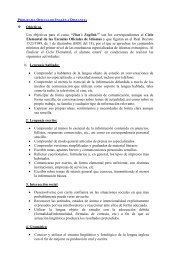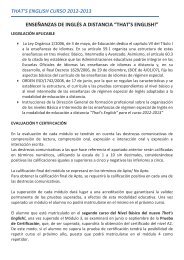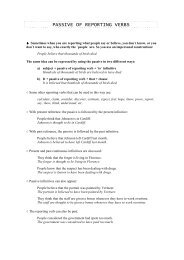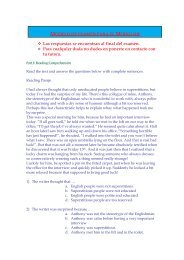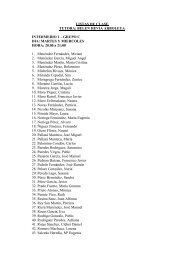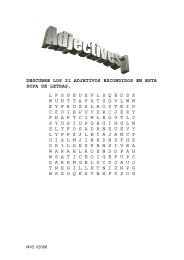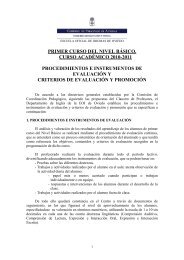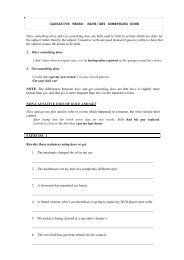Excerpt from 'East of Eden' By John Steinbeck Chapter 1 [1] THE ...
Excerpt from 'East of Eden' By John Steinbeck Chapter 1 [1] THE ...
Excerpt from 'East of Eden' By John Steinbeck Chapter 1 [1] THE ...
Create successful ePaper yourself
Turn your PDF publications into a flip-book with our unique Google optimized e-Paper software.
<strong>Excerpt</strong> <strong>from</strong> <strong>'East</strong> <strong>of</strong> <strong>Eden'</strong><br />
<strong>By</strong> <strong>John</strong> <strong>Steinbeck</strong><br />
<strong>Chapter</strong> 1<br />
[1]<br />
<strong>THE</strong> SALINAS VALLEY is in Northern California. It is a long narrow swale<br />
between two ranges <strong>of</strong> mountains, and the Salinas River winds and twists up<br />
the center until it falls at last into Monterey Bay.<br />
I remember my childhood names for grasses and secret flowers. I remember<br />
where a toad may live and what time the birds awaken in the summer—and<br />
what trees and seasons smelled like—how people looked and walked and<br />
smelled even. The memory <strong>of</strong> odors is very rich.<br />
I remember that the Gabilan Mountains to the east <strong>of</strong> the valley were light gay<br />
mountains full <strong>of</strong> sun and loveliness and a kind <strong>of</strong> invitation, so that you wanted<br />
to climb into their warm foothills almost as you want to climb into the lap <strong>of</strong> a<br />
beloved mother. They were beckoning mountains with a brown grass love. The<br />
Santa Lucias stood up against the sky to the west and kept the valley <strong>from</strong> the<br />
open sea, and they were dark and brooding—unfriendly and dangerous. I<br />
always found in myself a dread <strong>of</strong> west and a love <strong>of</strong> east. Where I ever got<br />
such an idea I cannot say, unless it could be that the morning came over the<br />
peaks <strong>of</strong> the Gabilans and the night drifted back <strong>from</strong> the ridges <strong>of</strong> the Santa<br />
Lucias. It may be that the birth and death <strong>of</strong> the day had some part in my feeling<br />
about the two ranges <strong>of</strong> mountains.<br />
From both sides <strong>of</strong> the valley little streams slipped out <strong>of</strong> the hill canyons and<br />
fell into the bed <strong>of</strong> the Salinas River. In the winter <strong>of</strong> wet years the streams ran<br />
full-freshet, and they swelled the river until sometimes it raged and boiled, bank<br />
full, and then it was a destroyer. The river tore the edges <strong>of</strong> the farm lands and<br />
washed whole acres down; it toppled barns and houses into itself, to go floating<br />
and bobbing away. It trapped cows and pigs and sheep and drowned them in its<br />
muddy brown water and carried them to the sea. Then when the late spring<br />
came, the river drew in <strong>from</strong> its edges and the sand banks appeared. And in the<br />
summer the river didn't run at all above ground. Some pools would be left in the<br />
deep swirl places under a high bank. The tules and grasses grew back, and<br />
willows straightened up with the flood debris in their upper branches. The<br />
Salinas was only a part-time river. The summer sun drove it underground. It<br />
was not a fine river at all, but it was the only one we had and so we boasted<br />
about it—how dangerous it was in a wet winter and how dry it was in a dry<br />
summer. You can boast about anything if it's all you have. Maybe the less you<br />
have, the more you are required to boast.<br />
The floor <strong>of</strong> the Salinas Valley, between the ranges and below the foothills, is<br />
level because this valley used to be the bottom <strong>of</strong> a hundred-mile inlet <strong>from</strong> the<br />
sea. The river mouth at Moss Landing was centuries ago the entrance to this<br />
long inland water. Once, fifty miles down the valley, my father bored a well. The
drill came up first with topsoil and then with gravel and then with white sea sand<br />
full <strong>of</strong> shells and even pieces <strong>of</strong> whalebone. There were twenty feet <strong>of</strong> sand and<br />
then black earth again, and even a piece <strong>of</strong> redwood, that imperishable wood<br />
that does not rot. Before the inland sea the valley must have been a forest. And<br />
those things had happened right under our feet. And it seemed to me<br />
sometimes at night that I could feel both the sea and the redwood forest before<br />
it.<br />
On the wide level acres <strong>of</strong> the valley the topsoil lay deep and fertile. It required<br />
only a rich winter <strong>of</strong> rain to make it break forth in grass and flowers. The spring<br />
flowers in a wet year were unbelievable. The whole valley floor, and the foothills<br />
too, would be carpeted with lupins and poppies. Once a woman told me that<br />
colored flowers would seem more bright if you added a few white flowers to give<br />
the colors definition. Every petal <strong>of</strong> blue lupin is edged with white, so that a field<br />
<strong>of</strong> lupins is more blue than you can imagine. And mixed with these were<br />
splashes <strong>of</strong> California poppies. These too are <strong>of</strong> a burning color—not orange,<br />
not gold, but if pure gold were liquid and could raise a cream, that golden cream<br />
might be like the color <strong>of</strong> the poppies. When their season was over the yellow<br />
mustard came up and grew to a great height. When my grandfather came into<br />
the valley the mustard was so tall that a man on horseback showed only his<br />
head above the yellow flowers. On the uplands the grass would be strewn with<br />
buttercups, with hen-and-chickens, with black-centered yellow violets. And a<br />
little later in the season there would be red and yellow stands <strong>of</strong> Indian<br />
paintbrush. These were the flowers <strong>of</strong> the open places exposed to the sun.<br />
Under the live oaks, shaded and dusky, the maidenhair flourished and gave a<br />
good smell, and under the mossy banks <strong>of</strong> the water courses whole clumps <strong>of</strong><br />
five-fingered ferns and goldy-backs hung down. Then there were harebells, tiny<br />
lanterns, cream white and almost sinful looking, and these were so rare and<br />
magical that a child, finding one, felt singled out and special all day long.<br />
When June came the grasses headed out and turned brown, and the hills<br />
turned a brown which was not brown but a gold and saffron and red—an<br />
indescribable color. And <strong>from</strong> then on until the next rains the earth dried and the<br />
streams stopped. Cracks appeared on the level ground. The Salinas River sank<br />
under its sand. The wind blew down the valley, picking up dust and straws, and<br />
grew stronger and harsher as it went south. It stopped in the evening. It was a<br />
rasping nervous wind, and the dust particles cut into a man's skin and burned<br />
his eyes. Men working in the fields wore goggles and tied handkerchiefs around<br />
their noses to keep the dirt out.<br />
The valley land was deep and rich, but the foothills wore only a skin <strong>of</strong> topsoil<br />
no deeper than the grass roots; and the farther up the hills you went, the thinner<br />
grew the soil, with flints sticking through, until at the brush line it was a kind <strong>of</strong><br />
dry flinty gravel that reflected the hot sun blindingly.<br />
I have spoken <strong>of</strong> the rich years when the rainfall was plentiful. But there were<br />
dry years too, and they put a terror on the valley. The water came in a thirtyyear<br />
cycle. There would be five or six wet and wonderful years when there<br />
might be nineteen to twenty-five inches <strong>of</strong> rain, and the land would shout with
grass. Then would come six or seven pretty good years <strong>of</strong> twelve to sixteen<br />
inches <strong>of</strong> rain. And then the dry years would come, and sometimes there would<br />
be only seven or eight inches <strong>of</strong> rain. The land dried up and the grasses headed<br />
out miserably a few inches high and great bare scabby places appeared in the<br />
valley. The live oaks got a crusty look and the sage-brush was gray. The land<br />
cracked and the springs dried up and the cattle listlessly nibbled dry twigs. Then<br />
the farmers and the ranchers would be filled with disgust for the Salinas Valley.<br />
The cows would grow thin and sometimes starve to death. People would have<br />
to haul water in barrels to their farms just for drinking. Some families would sell<br />
out for nearly nothing and move away. And it never failed that during the dry<br />
years the people forgot about the rich years, and during the wet years they lost<br />
all memory <strong>of</strong> the dry years. It was always that way.<br />
[2]<br />
And that was the long Salinas Valley. Its history was like that <strong>of</strong> the rest <strong>of</strong> the<br />
state. First there were Indians, an inferior breed without energy, inventiveness,<br />
or culture, a people that lived on grubs and grasshoppers and shellfish, too lazy<br />
to hunt or fish. They ate what they could pick up and planted nothing. They<br />
pounded bitter acorns for flour. Even their warfare was a weary pantomime.<br />
Then the hard, dry Spaniards came exploring through, greedy and realistic, and<br />
their greed was for gold or God. They collected souls as they collected jewels.<br />
They gathered mountains and valleys, rivers and whole horizons, the way a<br />
man might now gain title to building lots. These tough, dried-up men moved<br />
restlessly up the coast and down. Some <strong>of</strong> them stayed on grants as large as<br />
principalities, given to them by Spanish kings who had not the faintest idea <strong>of</strong><br />
the gift. These first owners lived in poor feudal settlements, and their cattle<br />
ranged freely and multiplied. Periodically the owners killed the cattle for their<br />
hides and tallow and left the meat to the vultures and coyotes.<br />
When the Spaniards came they had to give everything they saw a name. This is<br />
the first duty <strong>of</strong> any explorer—a duty and a privilege. You must name a thing<br />
before you can note it on your hand-drawn map. Of course they were religious<br />
people, and the men who could read and write, who kept the records and drew<br />
the maps, were the tough untiring priests who traveled with the soldiers. Thus<br />
the first names <strong>of</strong> places were saints' names or religious holidays celebrated at<br />
stopping places. There are many saints, but they are not inexhaustible, so that<br />
we find repetitions in the first namings. We have San Miguel, St. Michael, San<br />
Ardo, San Bernardo, San Benito, San Lorenzo, San Carlos, San Francisquito.<br />
And then the holidays—Natividad, the Nativity; Nacimiente, the Birth; Soledad,<br />
the Solitude. But places were also named <strong>from</strong> the way the expedition felt at the<br />
time: Buena Esperenza, good hope; Buena Vista because the view was<br />
beautiful; and Chualar because it was pretty. The descriptive names followed:<br />
Paso de los Robles because <strong>of</strong> the oak trees; Los Laureles for the laurels;<br />
Tularcitos because <strong>of</strong> the reeds in the swamp; and Salinas for the alkali which<br />
was white as salt.<br />
Then places were named for animals and birds seen—Gabilanes for the hawks<br />
which flew in those mountains; Topo for the mole; Los Gatos for the wild cats.
The suggestions sometimes came <strong>from</strong> the nature <strong>of</strong> the place itself: Tassajara,<br />
a cup and saucer; Laguna Seca, a dry lake; Corral de Tierra for a fence <strong>of</strong><br />
earth; Paraiso because it was like Heaven.<br />
Then the Americans came—more greedy because there were more <strong>of</strong> them.<br />
They took the lands, remade the laws to make their titles good. And farmholds<br />
spread over the land, first in the valleys and then up the foothill slopes, small<br />
wooden houses ro<strong>of</strong>ed with redwood shakes, corrals <strong>of</strong> split poles. Wherever a<br />
trickle <strong>of</strong> water came out <strong>of</strong> the ground a house sprang up and a family began to<br />
grow and multiply. Cuttings <strong>of</strong> red geraniums and rosebushes were planted in<br />
the dooryards. Wheel tracks <strong>of</strong> buckboards replaced the trails, and fields <strong>of</strong> corn<br />
and barley and wheat squared out <strong>of</strong> the yellow mustard. Every ten miles along<br />
the traveled routes a general store and blacksmith shop happened, and these<br />
became the nuclei <strong>of</strong> little towns, Bradley, King City, Greenfield.<br />
The Americans had a greater tendency to name places for people than had the<br />
Spanish. After the valleys were settled the names <strong>of</strong> places refer more to things<br />
which happened there, and these to me are the most fascinating <strong>of</strong> all names<br />
because each name suggests a story that has been forgotten. I think <strong>of</strong> Bolsa<br />
Nueva, a new purse; Morocojo, a lame Moor (who was he and how did he get<br />
there?); Wild Horse Canyon and Mustang Grade and Shirt Tail Canyon. The<br />
names <strong>of</strong> places carry a charge <strong>of</strong> the people who named them, reverent or<br />
irreverent, descriptive, either poetic or disparaging. You can name anything San<br />
Lorenzo, but Shirt Tail Canyon or the Lame Moor is something quite different.<br />
The wind whistled over the settlements in the afternoon, and the farmers began<br />
to set out mile-long windbreaks <strong>of</strong> eucalyptus to keep the plowed topsoil <strong>from</strong><br />
blowing away. And this is about the way the Salinas Valley was when my<br />
grandfather brought his wife and settled in the foothills to the east <strong>of</strong> King City.


![Excerpt from 'East of Eden' By John Steinbeck Chapter 1 [1] THE ...](https://img.yumpu.com/12144084/1/500x640/excerpt-from-east-of-eden-by-john-steinbeck-chapter-1-1-the-.jpg)


